Revisiting the South: Richard Misrach’s Cancer Alley depicts the Deep South as a fertile landscape rendered toxic by capitalist interests and racial inequalities. This exhibition, currently on view at the High Museum, features 21 large-scale prints commissioned over a 14-year period as part of the museum’s Picturing the South series. The majority of the images focus on the industrial buildings and refuse that led one particular area of the Mississippi River to be dubbed “Cancer Alley,” while the most recent respond to the events surrounding the Deepwater Horizon Oil Spill. The show attempts to connect these environmental atrocities and emphasize their significance through Misrach’s signature usage of grand scale and dramatic composition. In many of these works, however, Misrach’s eye for composition overwhelms the context, causing the exhibition to come across as disjointed though not without its successes.
The exhibition serves as an interesting tutelage of the use and misuse of dramatic compositional techniques in photography. Home and Grain Elevator, Destrehan, Louisiana, negative 1998, inkjet print 2012, depicts a concrete grain elevator towering majestically over the landscape. The curves and scale of the elevator, strategically cropped by Misrach’s lens, resembles a Gothic cathedral draped in concrete, dwarfing the helpless one-story homes below. The effect is stunningly beautiful, yet subtly uncomfortable; the houses, disturbingly close to their industrial neighbor, are easily overlooked in the first glance in favor of the impressive structure behind them.
In another vein, however, is Helicopter Returning from Deepwater Horizon Spill, Venice, Louisiana, negative 2010, print 2012. The helicopter of the title is captured as it passes directly over a cow on a green knoll, flanked by a hierarchical cow on each side. It’s a lucky piece of photographer’s comic-timing, but as part of this series it comes off as ridiculous, with only the most tenuous of relations to the disaster referenced in the title.
Other photographs stumble into obvious juxtaposition, to the detriment of their impact. Holy Rosary Cemetery and Dow Chemical Corporation (Union Carbide Complex), Taft, Louisiana, negative 1998, print 2012, shows in the foreground a cemetery whose marble crosses are mimicked by smoke stacks and electric poles in the background. The symbolism is so obvious it hurts. Playground and Shell Refinery, Norco, Louisiana, negative 1998, print 2012, is similarly stale. An empty basketball court lies before a sprawling oil refinery. Bereft of players and juxtaposed with the expansive factory, the causal connection imposed on the viewer is clear but without emotional import. The text accompanying this work informs the viewer that the court is all that remains of an all-black elementary school that was burned to the ground in 1968 on the eve of integration. The text further states that Shell, owner of the refinery, was forced after decades of lawsuits to relocate most of the residents. The story is unbelievably horrifying and tragic, evoking the very real and recent battles for integration. The image fails to convey any of this. As supplement to the story, it may serve a journalistic purpose, but as art it disappoints.

All the faults of this show can be overlooked with the spell-binding Hazardous Waste Containment Site, Dow Chemical Corporation, Mississippi River, Plaquemine, Louisiana, negative 1998, print 2012. A chain-link fence stretches before an opening in the trees, half submerged in gray marsh water. The water acts as a mirror, splitting the scene into vertical halves. The scene hints at Monet’s Bridge Over a Pond of Water Lilies, but where Monet’s stream was flower-filled lushness, Misrach’s is chillingly flat excepting some questionable refuse drifting in one corner. You don’t need to read the text or title to feel the dangerous toxicity of this place. In Hazardous Waste Containment Site, Misrach captured a truly haunting aspect of the Southern landscape, one far more real and chilling than any folk-legend or cliché.






